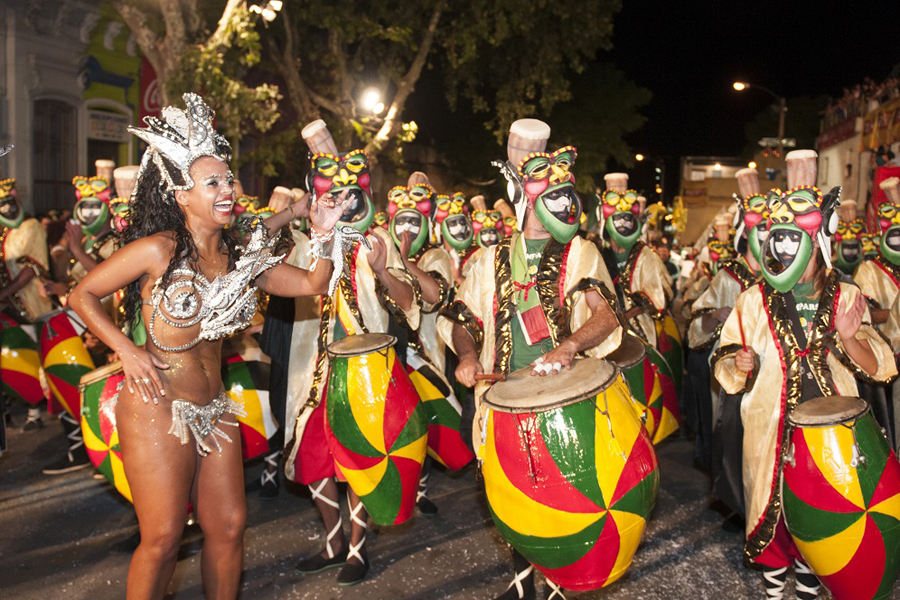Uruguay has the longest carnival in the world. It begins in late January and continues through mid-March. For approximately 40 days, thousands of people go to the streets or house of shows to accompany the various attractions, which are displayed throughout the country, and are marked by the mixture of African and European cultures.
Started in Montevideo, it is one of the oldest and most popular traditions of Uruguayan culture. The initial foot tip is given each year with the Inaugural Parade on Avenida 18 de Julio, which this year takes place on January 25th. All groups involved in the official contest of the capital participate accompanied by floats and courtship of Queens Carnival.
Besides the presentation on 18 de Julio Avenue, there are the famous “Llamadas” parades. With strong influence of African culture under the sound of Candombe, this year will take place on February 8 and 9 and will pass through the neighborhood: Sur and Palermo, also in the Uruguayan capital. Tradition evokes and recalls the encounters of the slaves, who met outside the city during the eighteenth and nineteenth centuries. The strength and color of the African rhythm make visitors vibrate, the manifestation is characterized by the dialogue of three types of drums: boy, peal and piano.
The moving spectacle is the biggest in the world when it comes to drums being played at the same time: they are more than 2500 unisoning instruments, shivering the soul of the spectators.
In addition to enjoying and dancing under the sound of Candombe drums, visitors can enjoy the Murga, a rhythm of Spanish origin that mixes theater, parody, humor and melody. The genre is one of the most genuine expressions of the Uruguayan culture, mainly for its popular participation. In the evenings of February the sets go through scenes of neighborhoods – tablados mounted in the streets during the period of carnival, where they usually present themselves.
For 35 days, the carnival groups of Murgas, Parodists, Humorists and Music Magazines participate in the Official Carnival Competition, where they present with humor and satire the vision of the country and the world, accompanied by various choral arrangements, flashy costumes and creative make-up. In addition to Montevideo, all cities in the interior of Uruguay have their inaugural parades. Some cities are influenced by other countries such as Rivera, Artígas and Melo, localities bordering Brazil, that adopt different elements of our carnival.
In Montevideo, it is possible to visit the Carnival Museum all year round. There it is exposed the memory of the carnival and it harbors part of the national history. Check the site: http://museodelcarnaval.org/
As societies of Afrodescendants and Lubolos or Comparsas de Candombe are heirs of a tradition involved in the denominated Rooms of Nation of the Colonial time. Africans brought in as slaves managed to convey the values of their culture. Recognized as Intangible Heritage of Mankind, Candombe seduces visitors with the peculiar sound of its three drums. In the Call Parade they play in unison, along the route, 2,500 drums that constitute the essence of the comparsa.The rhythm of the Candombe comes from the denominated rope, group formed by three types of drums: piano, peal and small. It is played by beating or leather with an open hand and a drumstick that can also hit the wood, always hanging by the shoulder by a strap allowing the instrumentalist to walk while playing.
Before the rope of drums, whose number can be surpass the seventy members, they go ahead with their costumes typical of the rest of the comparsa (march). The “Llamadas” parade takes its name from “the call of the drum”, which Afrodescendants held to gather (in extramuros), far from their masters’ property, since the late nineteenth century in some tenements in specific areas of Montevideo .
The march of each group is opened by a banner, symbolizing the emblem of the Tribe or Ethnicity. Then the dance body and the ancestral characters appear. Characters such as the Gramilleiro, wizard of the tribe, Mama Vieja, Escobero and Vedettes.
Although it identifies itself with origin Cadiz, a city located in the south of Spain, since 1908, has undergone many transformations, Uruguayan Murga in the last decades has been transformed culturally and has been welcoming more and more followers from all over the world. The Murgas carry an amplitude of musical rhythms, among them the “truck march”, that identify percussion bars of the drum and the plate. Clothing and makeup bear the legacy of other expressions in European art.Currently, Uruguayan Murga consists of 17 members: a choir and stage director, 13 choristers or “cuerda de voces”, divided according to their tone of voice and 3 members form the drums, with plates, kicks and redoubled. The presentations run through public and private venues mainly from Montevideo and the interior of the country, bringing to the scene lyrics with humor, satire and criticism of current themes, usually related to politics and social criticism.
The carnival is born in the neighborhoods and most have a Murga to cheer, support or follow, sometimes in the parades now in the official competitions, which has a qualifying jury awarding prizes and mentions.
The rehearsals are open to the public, this allows entire families to memorize and chant their repertoires.
Photos: Leonardo Correa

